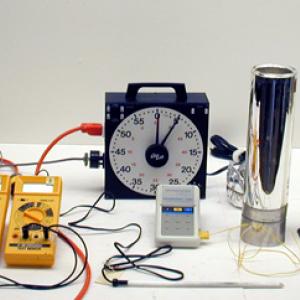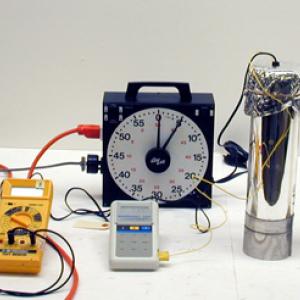College of Liberal Arts & Sciences
5F15.10 - Electrical Equivalent of Heat
Set up as shown and by running the experiment for a set amount of time, measuring the voltage and current, and the temperature rise, you should be able to calculate the electrical equivalent of heat.
Measure 1 liter of water into the Dewar. Place the covering which contains the heater and bead thermocouple onto the Dewar. Set the countdown timer for 5 minutes. This heater runs at about 3.5 amps and will heat the 1 liter of water approximately 30 degrees Celsius in 5 minutes.
If using the larger knife style heater with the above conditions you can expect the heater to run at about 2.5 amps and give a temperature rise of over 20 degrees Celsius in 5 minutes.
- Thomas B. Greenslade Jr., "Nineteenth‐Century Measurements of the Mechanical Equivalent of Heat", TPT, Vol. 40, #4, Apr. 2002, p. 243.
- William Hooper, "No Cal", TPT, Vol. 31, #2, Feb. 1993, p. 68.
- Louie A. Galloway III and John F. Wilson Jr., "Measuring the Mechanical Equivalent of Heat—Electrically", TPT, Vol. 30, #8, Nov. 1992, p. 504.
- Brother T. G. Bullen, "Alternative Setup for Joule’s Law", TPT, Vol. 19, #5, May 1981, p. 280.
- Ronald F. Gleeson and Melvin Deak, "Joule's Law Experiment", TPT, Vol. 19, #2, Feb. 1981, p. 119.
- Bruce Jones, "A Stirring Experiment", TPT, Vol. 18, #9, Dec. 1980, p. 671, also A Potpourri of Physics Teaching Ideas - Odds and Ends, p. 310.
- Frank G. Karioris, "Tricks of the Trade: Inexpensive Immersion Heater", TPT, Vol. 12, #9, Dec. 1974, p. 573.
- Samuel C. Dickieson, "Relating Heat and Electrical Units with Immersion Heaters", TPT, Vol. 10, #5, May 1972, p. 268.
- T. E. Neil and P. D. Schulze, "Mechanical Equivalent of Heat: Electrical Method by Vaporization of Liquid Nitrogen", AJP, Vol. 54, #5, May 1986, p. 474.
- C. W. Tompson and H. W. White, "Latent Heat and Low-Temperature Heat Capacity Experiment for the General Physics Laboratory", AJP, Vol. 51, #4, Apr. 1983, p. 362.
- G. D. Freier and F. J. Anderson, "He-4", A Demonstration Handbook for Physics.
- G. D. Freier and F. J. Anderson, "Eh-3", A Demonstration Handbook for Physics.
- John L. Roeder, "Activity 6.Converting Electrical to Thermal Energy", Teaching About Energy, p. 83.
- David Kutliroff, "91. Heating Effect of an Electric Current", 101 Classroom Demonstrations and Experiment For Teaching Physics, p. 202.
- Robert Ehrlich, "L.10. Conversion of Electrical to Thermal Energy", Turning the World Inside Out and 174 Other Simple Physics Demonstrations, p. 152 - 153.
Disclaimer: These demonstrations are provided only for illustrative use by persons affiliated with The University of Iowa and only under the direction of a trained instructor or physicist. The University of Iowa is not responsible for demonstrations performed by those using their own equipment or who choose to use this reference material for their own purpose. The demonstrations included here are within the public domain and can be found in materials contained in libraries, bookstores, and through electronic sources. Performing all or any portion of any of these demonstrations, with or without revisions not depicted here entails inherent risks. These risks include, without limitation, bodily injury (and possibly death), including risks to health that may be temporary or permanent and that may exacerbate a pre-existing medical condition; and property loss or damage. Anyone performing any part of these demonstrations, even with revisions, knowingly and voluntarily assumes all risks associated with them.

